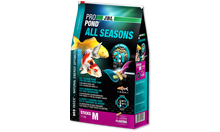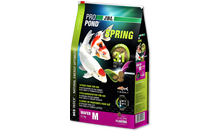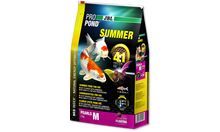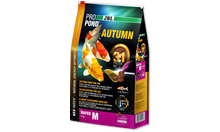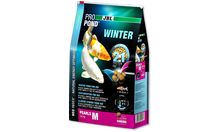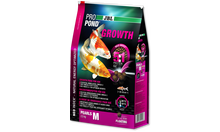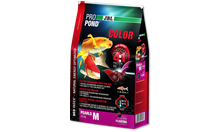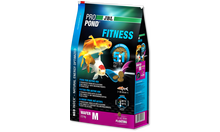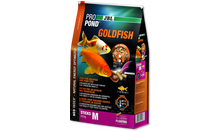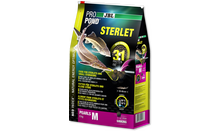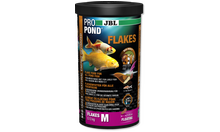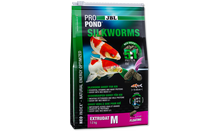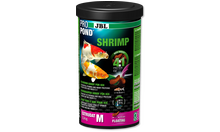THE PROFESSIONAL POND FISH NUTRITION WITH THE NEO INDEX®.
THE ONLY PHYSIOLOGICAL-NUTRITIONAL CONCEPT ON THE MARKET
-
fish species
-
age / size
-
temperature
-
habitat
NEO Index® literally means: natural, energy-optimised nutrition. Behind this lies the ratio of proteins to fats in the food. Looking at the season alone, the fish would only need half as much protein in winter (2:1) as in summer (4:1). But because not only the season (meaning the water temperature), but also the size and age of the fish, and food function (e.g. growth food) play determining roles, the der NEO Index® has been developed to deal with all these factors in one. Feed your animals throughout the year with the natural, balanced JBL PROPOND fish food, to keep them healthy and active for the long-term. By supporting all their vital functions it ensures active, disease-resistant fish with vibrant colours. The food is highly digestible thanks to its prebiotic ingredients.
ONLY THE BEST THAT NATURE HAS TO OFFER - For our JBL PROPOND pond fish food we set the highest quality requirements for the foods’ ingredients. Every single component is examined in accordance with our specific JBL quality criteria before the ingredient is used for the food. Especially important for us are the controlled cultivation, the freshness and the pollution control. All PROPOND products of the physiological-nutritional concept contain high-quality ingredients in accordance with the NEO Index®.
THERE IS MUCH MORE BEHIND IT
SAME NEO Index® - DIFFERENT FOOD
If you think, for instance, that the spring food (JBL PROPOND SPRING) has the same protein/fat ratio (3:1) as the autumn food (JBL PROPOND AUTUMN), a glance at the exact composition shows that they are not the same food in different packages but that the ingredients show significant differences.
The spring food is a floating food. The protein and fat contents are lower than in the autumn food since no energy reserves need to be built up.
The autumn food is a sinking food. The crude fibre and crude ash contents are lower than in the spring food to prepare the digestive tract for the coming winter.
FISH GROW THROUGHOUT THEIR LIVES
If we visualized the growth of a fish as a growth curve it would become a rising curve which flattens at the top. The growth thus slows down with increasing age, but never stops. There can also be dents in the curve because fish growth is also dependent on food availability and living conditions. A 5 cm long koi weights about 2.2 g. When it reaches its threefold size, its weight will have increased to nearly 60 g. When it is 50 cm in length it will weigh over 2 kg. A 50 cm koi needs approx. 110 g food per day since it needs 3.5-5 % of its body weight as daily nutrition.
What makes the JBL PROPOND food concept so special? The ingredients used in the formulas are the key to healthy animals in their pond. The food quantity alone won’t satisfy your fish. The JBL PROPOND concept enables you to meet your fish’s demanding requirements.
Learn more about your fish’s energy requirements in the myJBL blogAS VARIED AS THE DEMANDS ON THE FISH’S METABOLISM
Even if your pond fish are always hungry and happy to eat any food they can get it’s important to get to grips with the subject of correct nutrition. It is not enough to select the right seasonal food. Proper nutrition needs to provide energy at the right time and in the right place. Fish are cold-blooded animals! Therefore their metabolism always depends on the ambient temperature (water temperature). While you need to stop feeding in cold winter temperatures (below 5 degree Celsius), the fish need more and more food as the temperature increases. Although the metabolism of the fish depends on the ambient temperature, a classification into metabolic rate, (required for the maintenance of the life functions), and the active metabolic rate can still be made. These types of energy are dependent on the ambient temperature, age, sex and the activity of the fish.
VARIETY OF SHAPES/DIVERSITY FOR EVERY PURPOSE
Let’s just compare fish food with our vegetables. You can eat vegetables raw, cooked, in soup or as a gratin. Each of these can be very healthy, if it is prepared CORRECTLY and not overcooked. It is similar with fish food. We can offer the same ingredients in a different shape and form, which may be a flake, a stick or an extrudate. With a flake the fish need to expend a lot of energy per flake, because ONE flake contains very little weight and food. With sticks the situation is somewhat better, but they still contain three times more air than an extrudate. This is clearly illustrated by comparing the weights in the same packaging size. And the truth really is, the higher the weight per volume the better! Along with the variant, the size is important. For the fish too large food causes considerably more problems than too small food. Please therefore select the appropriate “grain size” for your fish stock and if in doubt, use the smaller size. For the sinking behaviour we have created two versions: floating food for spring and summer and sinking food for autumn and winter and for sturgeon species, which always feed at the bottom.
STICKS
WAFER
PEARLS
FLAKES
You will find clear information about the fish size the food was designed for on the JBL PROPOND packaging. Do not offer treats (Goodies) to fish smaller than 35 cm.
THE FOOD WITH THE NEO INDEX®
Feeding with JBL PROPOND, the only fish food range with the NEO Index®, means systematic feeding. Adapted to the optimal metabolism of your fish, JBL PROPOND provides a wide choice either as a complete food or to be combined with each other. That’s why the JBL PROPOND range is divided into the four elementary fields depicted: Season Food, Function Food, Special Food and Goody Food.
THE RIGHT FEED AMOUNT – FOR POND OWNERS AND POND DWELLERS
We have extended this habit to our fish and tend to feed them too much rather than too little. Furthermore feeding is fun and our fish love us as a result. Unfortunately overfeeding doesn’t only create blow fish, it also has other consequences. Uneaten food sinks to the ground and pollutes the water and the filter, with the result that algae eat gladly the food. Since fish never feel really satisfied, they always give the impression that they need to be fed. That’s why the correct food amount really is essential for healthy fish and a healthy pond! Clear tables on the bag show the feeding recommendation for each product. This will show you how much food your goldfish, koi or sterlet needs per day. The recommended food amount can either be given in one go, or (Ideally) in several portions throughout the day. The practical dosing cup will help you to determine the right food amount without kitchen scales, according to the feeding recommendation.
TOTAL FEED AMOUNT
TOTAL FEED AMOUNT
SINGLE FEED
COMBINED FEED
MORE THAN JUST PACKAGING
If you have ever kept a strong smelling cheese in an “airtight” container in the fridge you will know that packaging which is said to be airtight often isn’t, and the smell escapes. For fish food packaging the smell is not important, but keeping out the sunlight and air is. UV radiation and oxygen in the air destroy vitamins and gradually reduce the original quality of the food. Therefore the design of the packaging really plays a fundamental role! That’s why we have chosen JBL PROPOND bags to give your food the best possible protection. A bag, closed with a zipper, preserves the food perfectly. Remember: NEVER leave the food bag open and whenever possible use up your food within 3 months after the initial opening.
Anyone getting to grips with the subject of nutrition (also for us humans), will soon discover that proteins and fats are not all the same! This doesn’t only apply to our diet but also for the fish diet. The best model for high-quality food is the food spectrum of animals in the wild, because the animals’ organisms have been adapting and evolving for generations. All over the world scientists have been testing other natural food components for decades. These findings too have influenced the composition and product packaging of JBL PROPOND.
